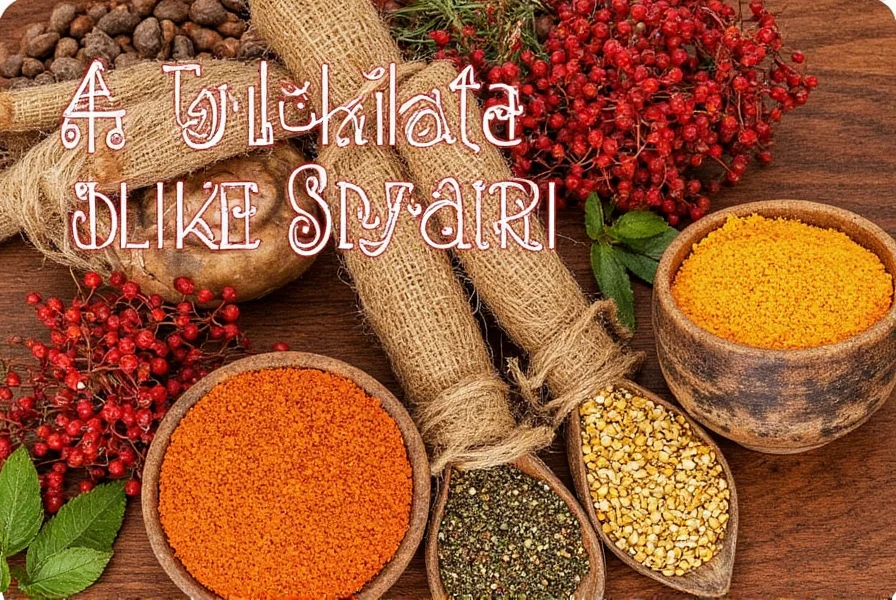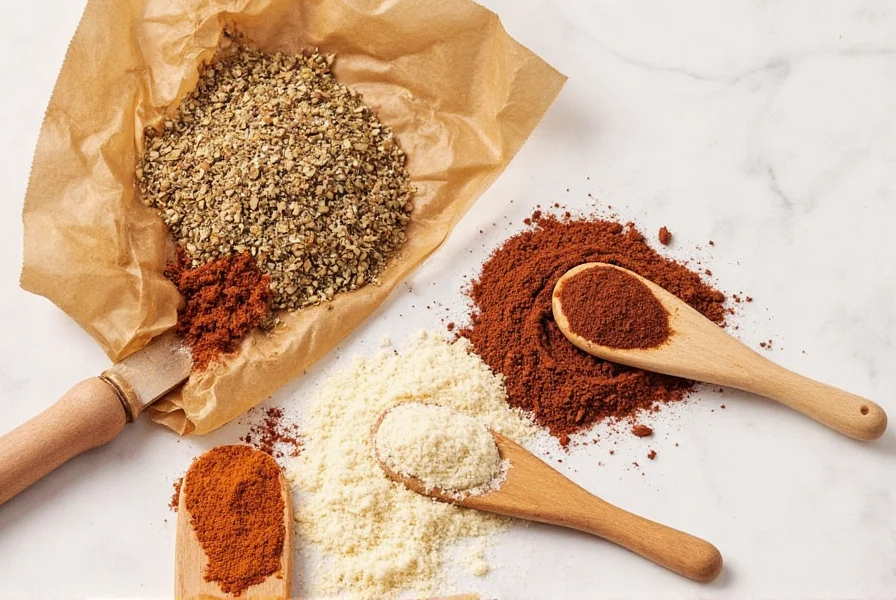Table of Contents
The Science Behind Spice Magic
Spices transform ordinary meals into extraordinary culinary experiences through complex chemical interactions. Understanding the science behind spices helps you use them more effectively. Most spices contain volatile compounds that interact with taste buds and olfactory receptors to enhance flavor profiles. For example:
- Cumin contains cuminaldehyde, which gives it its earthy aroma.
- Cinnamon gets its punch from cinnamaldehyde.
- Turmeric's vibrant yellow hue comes from curcumin, a powerful antioxidant.
The key is to use these ingredients thoughtfully. Overuse can lead to bitterness or overwhelming flavors, while underuse means missing out on potential depth. Knowing when and how to apply spices makes all the difference in your cooking.
Smart Spice Storage Hacks
Did you know that improper storage can make your beloved spices go stale in as little as six months? Here are some top tricks to keep them fresh longer:
- Airtight Containers: Transfer spices from their original packaging into glass jars with tight-fitting lids. Oxygen is the enemy of flavor!
- Keep Them Cool: Store your spices away from heat sources like ovens and stoves. A cool pantry is ideal.
- Dark Places Only: Light degrades quality. Use opaque containers or store spices in cabinets away from windows.
- No Moisture Zone: Keep dry spices dry! Consider placing a silica packet inside larger spice jars if you live in a humid area.
- Date Your Jars: Label each jar with the purchase date. Whole spices last up to 4 years; ground ones should be replaced every 2–3 years.
| Type of Spice | Shelf Life | Storage Tip |
|---|---|---|
| Whole Spices (e.g., peppercorns) | 3–4 years | Store in sealed jars |
| Ground Spices (e.g., paprika) | 2–3 years | Keep in dark cupboard |
| Dried Herbs (e.g., oregano) | 1–3 years | Avoid moisture |

Ways to Enhance Flavor Using Spices
You don't need to be a Michelin-starred chef to elevate your dishes. Here are five easy techniques to unlock complex flavors:
1. Toast Before You Use
Toasting spices in a dry skillet brings out their natural oils and aromas. Try it with coriander seeds, mustard seeds, or fennel before grinding or adding to soups and stews.
2. Bloom in Oil
In Indian and Middle Eastern cooking, blooming spices in oil is common. Heat oil in a pan, add whole or ground spices, and cook briefly until fragrant. This releases essential oils and intensifies flavor.
3. Layer Like a Pro
Add spices at different stages of cooking. Start with hardier ones early (like cumin in chili), and finish with delicate ones later (such as fresh basil).
4. Acid Balances Everything
If your dish feels heavy or too spicy, a splash of vinegar or citrus juice can cut through richness and balance flavors beautifully.
5. Salt is Your Secret Weapon
Salt enhances other flavors without overpowering them. Don't skip this step unless medically required — and even then, try using alternatives like lemon zest or herb blends.
Creative Uses for Everyday Spices
Let's think outside the shaker. These ideas might surprise you but trust us — they work!
- Black Pepper in Coffee: Adds warmth and depth to your morning brew. Just a pinch!
- Nutmeg in Mac 'n' Cheese: Gives a nutty richness and rounds out the dairy flavor.
- Cinnamon in Chili: Believe it or not, a dash of cinnamon adds subtle sweetness and complexity.
- Paprika in Brownies: Smoked paprika pairs surprisingly well with chocolate for a savory twist.
- Fennel Seeds as Mouth Freshener: Common in Mediterranean cultures. Chewing fennel seeds after meals helps with digestion and breath.
| Spice | Creative Use | Result |
|---|---|---|
| Black Pepper | In coffee | Warm, bold flavor boost |
| Nutmeg | In mac 'n' cheese | Richer, nuttier flavor |
| Cinnamon | In chili | Sweet complexity |
Frequently Asked Questions About Cooking with Herbs & Spices
How long do spices really last?
Whole spices maintain their potency for 3-4 years when stored properly, while ground spices last 2-3 years. Dried herbs typically stay fresh for 1-3 years. The best way to check freshness is by smelling them - if the aroma is weak or nonexistent, it's time to replace them.
What's the difference between herbs and spices?
Herbs generally come from the leafy parts of plants (like basil, cilantro, and parsley), while spices come from other parts of the plant such as seeds (coriander), roots (ginger), bark (cinnamon), or flowers (clove). Most herbs are used fresh, while spices are typically dried.
How can I tell if my spices are still fresh?
Fresh spices should have a strong, vibrant aroma and rich color. If your spices look faded or have little to no scent when you open the container, they've likely lost their potency. A simple test: rub a small amount between your fingers to release oils - if you can barely smell anything, it's time for a replacement.
Which spices should I always have in my pantry?
Every kitchen should have these essentials: salt, black pepper, garlic powder, onion powder, cumin, paprika (regular or smoked), oregano, and cinnamon. These provide a solid foundation for countless dishes across various cuisines.
Can I substitute dried herbs for fresh ones (and vice versa)?
Yes, but with adjustments. As a general rule, use 1 teaspoon of dried herbs for every 1 tablespoon of fresh herbs called for in a recipe. Dried herbs are more concentrated, so you need less. For the reverse substitution, use three times the amount of fresh herbs compared to dried.
Why do some recipes call for toasting spices?
Toasting spices in a dry pan releases their essential oils and enhances their natural flavors and aromas. This simple step can transform ordinary spices into extraordinary flavor contributors. Be careful not to burn them - toast over medium heat just until fragrant, usually 1-3 minutes.
What's the best way to store spices to keep them fresh?
Store spices in airtight glass containers away from heat, light, and moisture. The ideal location is a cool, dark pantry cabinet. Avoid storing spices above the stove where heat and steam can degrade them quickly. Always keep spices tightly sealed when not in use.
Are expensive spices worth the extra cost?
Often yes, especially for spices like saffron, vanilla, and high-quality cinnamon. Premium spices typically offer better flavor, purity, and potency. However, for common spices like paprika or oregano, reputable mid-range brands often provide excellent value. Always check freshness dates and storage conditions regardless of price point.
Spice Buying Guide: What to Look For
Not all spices are created equal. Here's what to consider when choosing your next bottle of magic:
Quality Matters
Opt for spices that have a strong aroma and vivid color. Dull colors and weak scent usually mean age or poor processing.
Organic vs. Conventional
Organic spices are grown without synthetic pesticides and may offer cleaner flavor. However, not all organic products are superior. Check sourcing and freshness.
Whole vs. Ground
Whole spices last longer and can be ground fresh when needed. Ideal for serious home chefs. Ground spices are convenient but degrade faster.
Recommended Brands
| Brand | Features | Best For |
|---|---|---|
| Penzeys Spices | High-quality, no artificial additives | Baking and everyday cooking |
| Spice Islands | Consistent flavor, affordable | Weeknight meals |
| Simply Organic | USDA certified organic | Health-conscious cooks |
Buying in Bulk?
If you cook often, buying in bulk can save money. Just make sure you have proper storage to maintain freshness.
Final Thoughts on Cooking with Herbs & Spices
Cooking with herbs & spices isn't just about flavor — it's about expression, creativity, and health. The right blend can transport you to another culture, awaken your senses, and even support wellness thanks to their antioxidant properties.
Whether you're a seasoned chef or someone who burns toast occasionally, there's always something new to learn. From smart storage solutions to wild ingredient pairings, the world of spices is full of possibilities waiting for you to explore.
So go ahead — shake things up in the kitchen. Dust off those old spice jars, experiment with toasting, or try a bold new combo. You might just discover your signature flavor along the way.
Happy seasoning!











 浙公网安备
33010002000092号
浙公网安备
33010002000092号 浙B2-20120091-4
浙B2-20120091-4